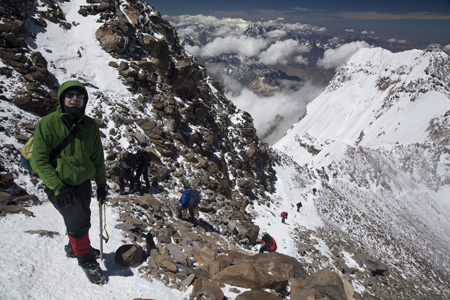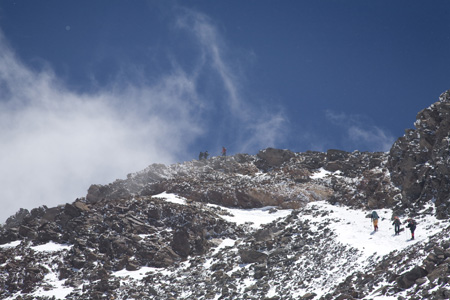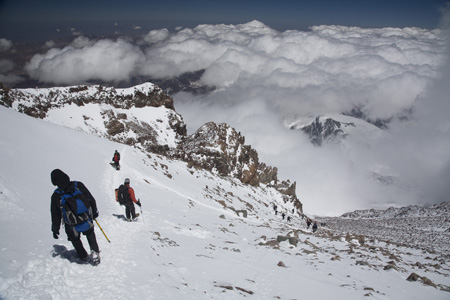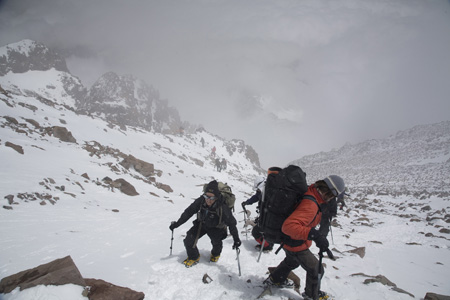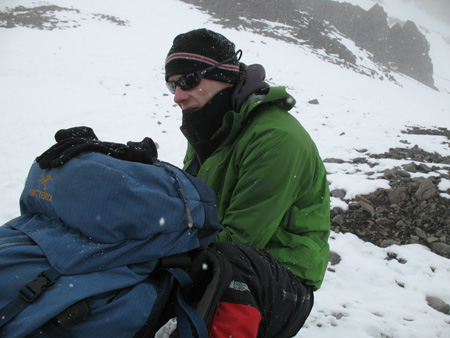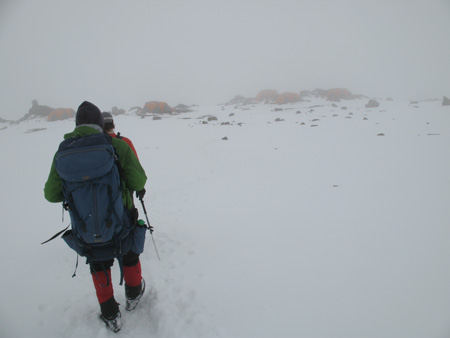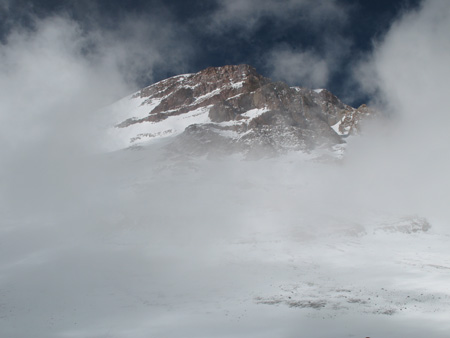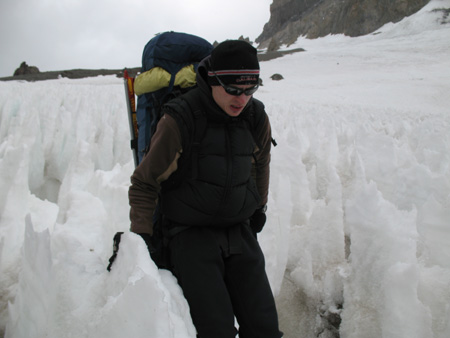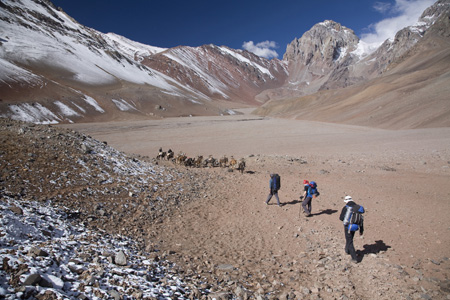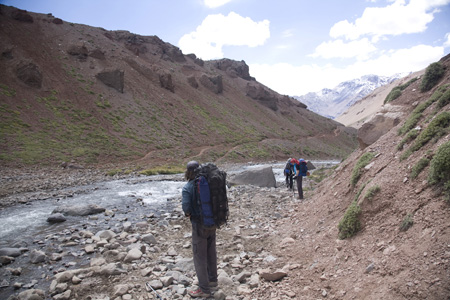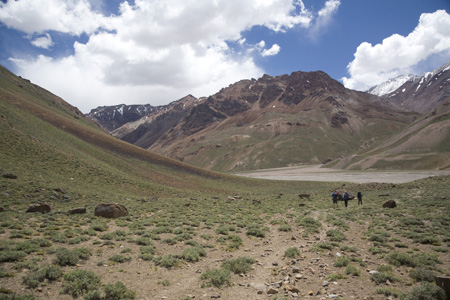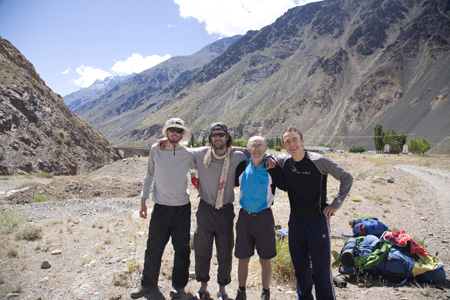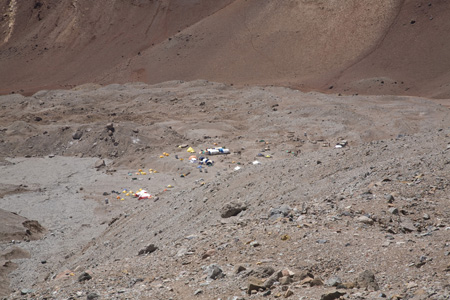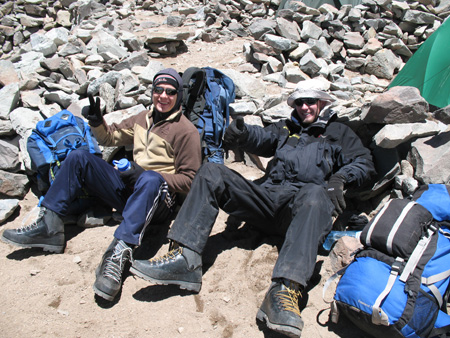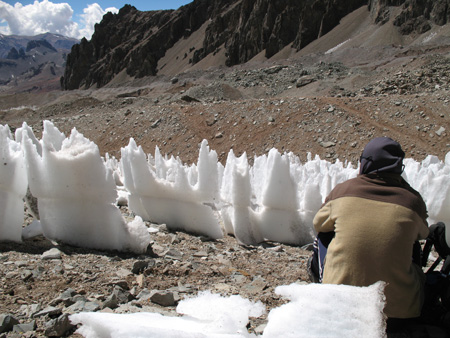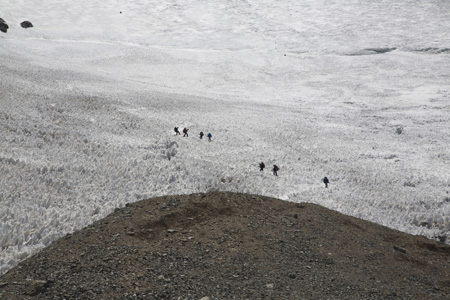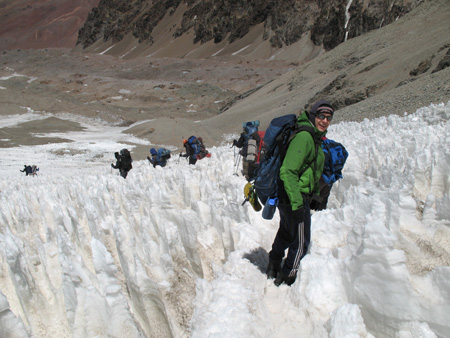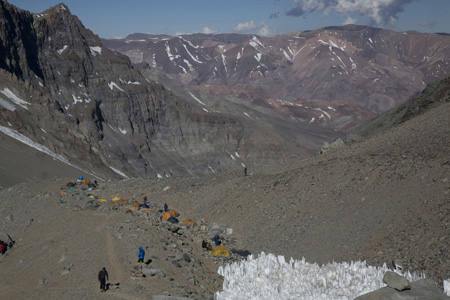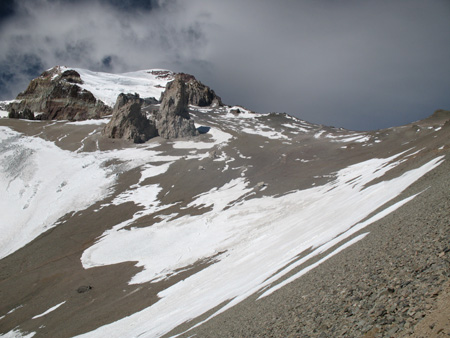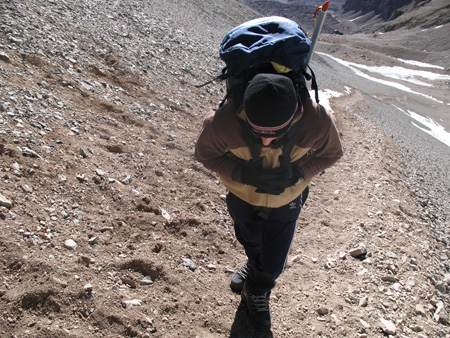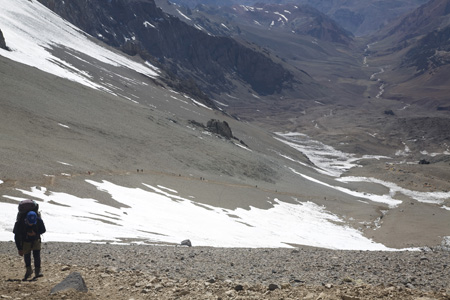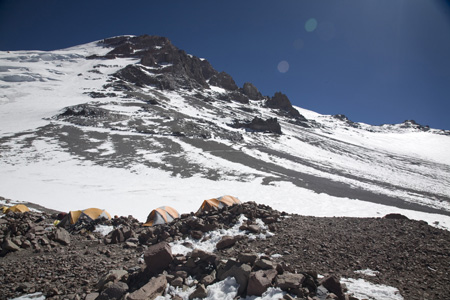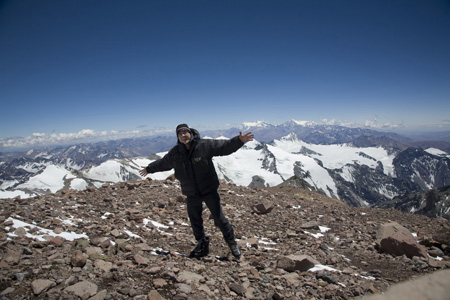When I last left off on the latest post, we had arrived at Camp 2 and were preparing for our summit attempt. Just to give you a little background, we had spent the day before carrying equipment to camp 2, the current day moving to camp 2, and then we just found out that the plan was to go the very next day and make a summit attempt. Now this was exactly what I didn’t want. The two days of walking up to camp 2 had tired me out, and making a summit attempt involved waking up at 2:00 or 3:00 in the morning, so we wouldn’t even get a good night’s sleep. However, according to Ryan it was the best thing to do, that spending idle time at camp 2 is worse in the end than getting to the top and being free to go home. I was not quite convinced at that point, but what could I do, the decision had been made to try for the summit the next day.
To make sure I was good to go when summit time came, I ate a nice big dehydrated meal, one of the worst meals I have ever had! It made my stomach semi-upset, and I had one of the worst nights of recent memory because 1) the meal did not agree with me and I had gas all night that kept me up, 2) it was the first night at a new high altitude which meant vivid dreams and bad quality sleep, 3) this would be night number 10 in a row sleeping in a tent in a sleeping bag on a thin foam pad in the cold (I had to cover my legs with my down jacket to stay warm, this was over top of my sleeping bag that was “aparently” rated to -40C), and 4) I was constantly waking up and thinking “is it time to get up yet? did I oversleep?” All that added up to a truly bad night, where I think I may have slept a couple hours max.
Anyways, early morning rolls along (I think the plan was to wake up at 2:30, leave at 3:30), I feel like total crap, I have a headache that could be from any one of the problems I listed above, but what can I do, the summit awaits! We eat some breakfast, start putting on all our gear, and we hit the road! Now at this time of the night it is very cold, I wish I could tell you the temperature but I didn’t know it. It had to be below -20C or even colder perhaps. Basically, it was REALLY cold, I think it felt like -35 or something. The problem with me telling you what it felt like is that after spending 10 nights sleeping in the cold and completely living in the cold and eating less than one should, you feel colder than you would normally. So I want to tell you it was -35C when really it was probably closer to -20/-25 C.
We walk along, working our way up. We can see little fireflies ahead shining on the route that we will be taking, and some other little lights following us as well; they are actually other groups ahead and behind us, working as we are, their lights dwarfed by the blackness all around.
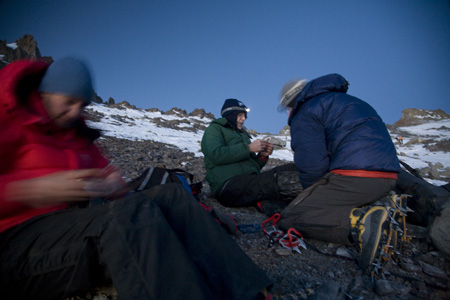
We had a brief stop at around the time the sky was starting to light up; Kerry’s feet were starting to feel cold, he didn’t put any warmers inside his boots before starting out. One of us had extras and Ryan helped him out so that it would go quicker.
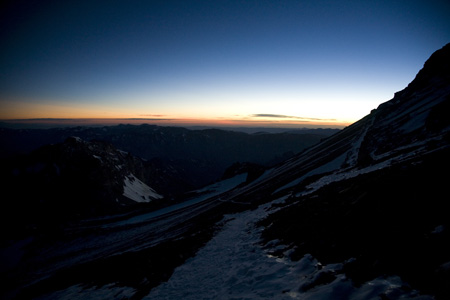
Looking back at the snowy route that we had followed, we see the orange light of day start to peek its way through, though never soon enough for our already cold bodies.
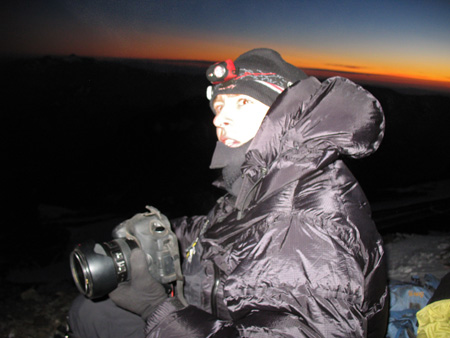
Emil managed to grab a decent shot of me as we sat there; my face mask is down at my neck, and my hood is off. The hood from my down jacket was on/off as my thermostat depending on how hot or cold I felt.
Brief break done we continue on, one small step at a time, each breath a little less satisfying than we would want. This continued on for another couple of hours until we reached a very windy point on the mountain. We started walking along a very exposed section with a strong cross-wind, and at Ryan’s advice we turned back; it was a part better left for when the wind calmed down a little. So we joined a couple of other groups and started to wait!
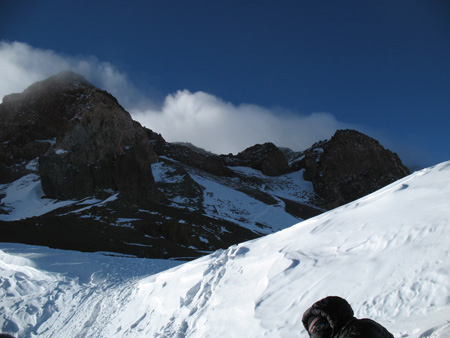
On the above picture we are looking up at part of the summit, along with the clouds moving past at a very high speed. This is where we waited, as we were out of the direct wind but still had a good view of the summit to see how the clouds and wind were behaving. On the bottom of the picture you can just barely see me, sitting down on the ground, my mask on my face, my hood on, trying everything to stay warm. At first I was standing and walking, moving around to try to stay warm. Eventually I became too tired to keep moving, yet too cold to sit down. It makes you realize how difficult it is to stop on a climb like this and do nothing. Your clothing is only meant to keep you warm while you are working and creating lots of body heat. It cannot keep you warm when you sit down and rest.
I can’t remember how long we stayed here and waited. I think it was less than an hour. Eventually the other group went down, and we still waited. Then it was time for us to make a decision: I voted we go down, as to me there was no point in standing there and waiting. I was getting colder and weaker, and if we were to suddenly rush off for the top I had my doubts about my ability to make it. The wait at this spot was just the latest in a series of things making my day a difficult one. And that’s what Ryan suggested as well, and so that’s what we did. Attempt number one on January 17th was abandoned and we set off the way we came, back down to the relative comfort of our tents.
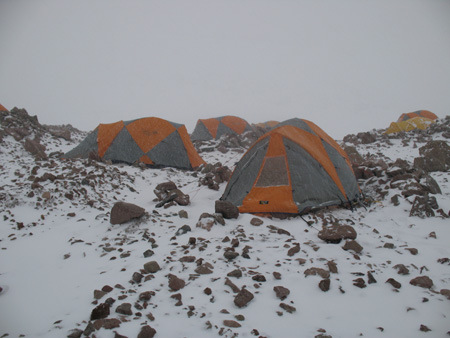
The way down was relatively uneventful in the grand scheme of things. The clouds that had constantly been blowing by the summit had started to work their way down, and so part of the way down we walked through these clouds and the snow they were depositing on us. At least we knew that turning back had been the right choice. There was no way we could have made the summit in that kind of weather. Above we see the blessed sight of our tents waiting for us after a very long day, and it wasn’t even 10:00 in the morning yet!
The rest of the day was spent eating and drinking, trying to get our energy up for the next attempt. The plan was as follows: we wake up at 3:00 am again and see if the weather is good enough to attempt another summit push.
I wasn’t sure anymore what would be better, to stay and rest or to go and get it over with. The headache I had had in the morning had not gone away, it was always there reminding me that I am in a place where you shouldn’t be for very long. Ryan’s advice about not staying at Camp 2 any longer than necessary was starting to make sense.
As night came the weather had not improved, and it definitely made the night quite interesting. The snow was still falling, and the wind was still howling and blowing. All night the wind would blow snow under the tent fly and the snow would sit packed along the inner fabric of the tent. As we slept our breath would condense and freeze on the inner walls of the tent, where the snow was sitting on the other side. Then every time the wind slapped the tent around we would be rewarded with tiny icicles made from our own breath raining down on our faces and sleeping bags. It was literally snowing inside our tent every time the wind shook it. It made for another night with little sleep; the only good thing about it was my thought that “with this weather we definitely won’t be attempting another summit push, so maybe we’ll get some longer sleep and we’ll all do better on the following day.” As 3:00 am rolled along that was indeed the case, we would not be doing another summit push today. It would be a day of rest!
Day of rest came, and it was good to take a break. However my headache was still there, and having only two painkillers left (that I wanted to save for the next summit push), I ended up having to take is as it came. This headache made everything that much more difficult, eating was harder, going to the bathroom was harder, going outside the tent to walk around or take some pictures was harder. Somehow I was not acclimatising as well up here as I had on some of the lower elevations (Camp 2 is at 5900 m).
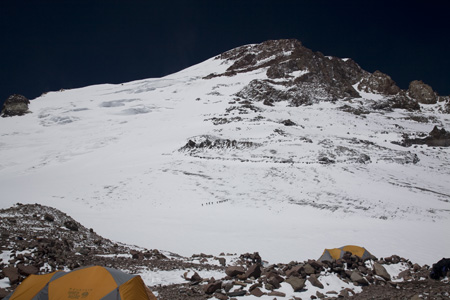
Above you can see a shot similar to the one I posted in the last post, looking up at the route we would take on our way up. The difference here is that the night’s snow storm had made the entire mountain side white, and the route is no longer visible on its own; all we can see is the group of climbers heading up and blazing a trail.
Without any other big events, night came and we planned to push for the summit again the next day. I think it was still snowing for part of the night, but the wind was not blowing as intense as the night before. I was feeling actually decent once 3:00 am came around! I still had the headache but I put my last two painkillers to work on that.
The day started off the same way as the one a few nights back. There was a bit more traffic, as everyone was taking this opportunity to try the summit; the bad weather had prevented anybody from summiting in the last two days. The only change in our group was that Kerry was not feeling in quite the same shape as on our first attempt. He was already feeling cold as we were setting out, and a little while into the trip he was getting cold in his extremities. Before the sun had had a chance to peek over the horizon, and while we were still within sight of our tents, he made the decision to turn back and left the three of us to try and reach the summit. Asking him about it later he had no regrets about turning back, he was just not feeling up to it; I wonder if I would have been smart enough to make that same choice were I in his shoes. I guess I have to be glad that the headache was the worst of my ailments at this altitude. But it also confirmed to me Ryan’s advice that you want to spend as little time as possible in the highest camps, as Kerry would have made the summit on the first attempt had the weather given us that opportunity.
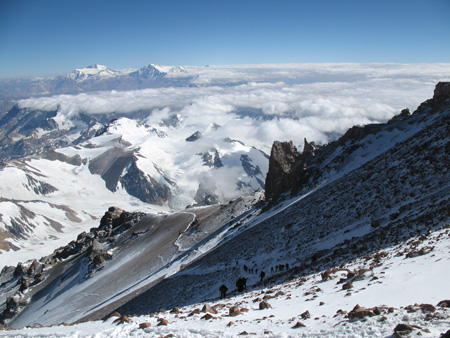
Once the sun had come out it was starting to look like quite a beautiful day. The picture above shows a look back at the groups following us. As you can see, already at this altitude there is the feeling of being on top of the world! Every mountain in view is well below, and we are left to just cling to the side of the mountain we are on.
While the view was definitely striking, I found myself thinking about other things on the way up. Mainly the thought that kept coming back into my head was “Why am I doing this again? Why did I just spend two weeks (and who knows how much still) of my life living on a mountain in a tent? Am I doing this to work my ass off, reach the top of some piece of rock, and stand there for half an hour? Is that really worth all the time, effort, and x thousand dollars?” These thought were going through my head now, but they deterred me only slightly. That happens when you are close to your physical and mental limit, when you look at the amount still left to climb, when you think of how nice it would be to turn around. In effect it’s all those weeks spent preparing, training, acclimatising that keep you going, the thought that “Well, I’ve made it this far, I can’t turn back with just a few hours to go.” But the temptation is there. Or maybe it’s not really a temptation to quit and turn back, but to never, ever, repeat anything like this. I felt the same way when I climbed Huayna Potosi in Bolivia, I said to myself “Wik, you’ve just gone through so much to stand on a piece of rock for a few minutes. It’s not worth it. Never do it again, it wasn’t even fun.” Yet here I was doing it again, asking myself why I hadn’t listened to myself from my first experience? Now let me digress a little and answer that question. After climbing the mountain in Bolivia I really felt that I never want to do anything like it in my life. It really was an experience I was unprepared for, untrained both physically and mentally, but most importantly I was severely lacking in experience. If I knew back in Bolivia what I know now about climbing mountains I would have had a much easier time. But such is life, you have to learn lessons, many of them the hard way. There are people all around us trying to give us advice, share the lessons they learned the hard way with us so that we don’t have to learn them the hard way. And now I am not just talking about climbing mountains, but life in general. How many times have we made mistakes in our lives, learned from them, only to realize it was the same kind of advice that people were giving us all along? I like to say, wise is the man who can learn from other people’s mistakes. I highly doubt there are many mistakes out there that have not yet been made by someone. But there are two ways to react to those tough lessons that life throws at us. The first is to learn from it, take it for the experience it is, and make sure you don’t put yourself into those same kind of situations again. The other way is to also learn from it, take it for the experience it is, but take it a step further, know that since you came out of it, you are now prepared to go through something like it again, maybe something even more severe. Now I write this with the theme of mountain climbing, that’s what this whole thing is about. But apply it to whatever you may need it to apply to in your life right now. Do you let bad things, bad experiences, stop you from doing anything in the future? Or do you come to the conclusion (sooner or later, doesn’t have to be right away) that all it was was a preparation for taking on even tougher things? That’s a lesson I learned; feel free to learn it on your own if you want.
As you can see, there’s a lot of time for thinking and analyzing life and philosophy when you have all this time to walk up a mountain. I think it’s a great opportunity to learn about oneself. Maybe that’s why I enjoy climbing mountains so much, you learn about yourself more than you think was there to learn.
Alright, getting back on track with the mountain climb. We were still working our way up the mountain, and there was still (what seemed like) a long way to go. At one point very close to the top we passed a group of climbers from the Argentinian military. They were on their way up to remove a body from near the summit. This had been a gentleman who had attempted to climb the mountain; just meters from reaching the summit he went into cardiac arrest and died. I don’t think we were aware of all those details as we climbed, but we got some advice from Ryan to NOT look at the body. If we were going to pass it on the way up, the best thing to do was to not look at it, as it can be quite haunting. Luckily the body was not on our route up.
With little further events, on January 19 2009, after spending 7 hours and 15 minutes climbing up, we made the summit of Aconcagua! 6962 meters above sea level! Top of the Americas, the western hemisphere, and the southern hemisphere!
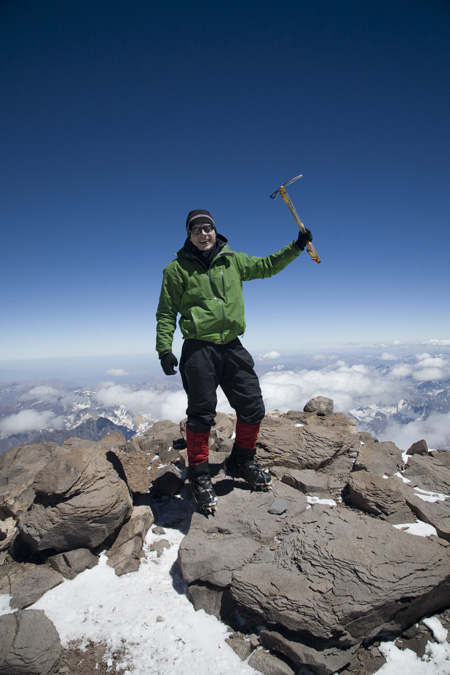
Posing the victorious pose with my ice axe in the air!
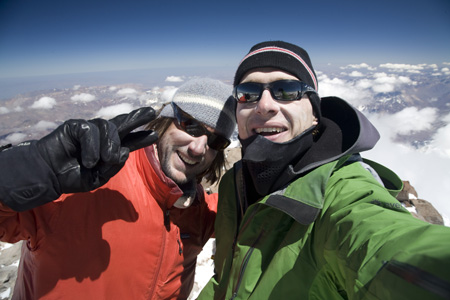
Ryan and me at the top. Much credit for us making the top goes to Ryan Waters, our guide and more on this trip. There are a lot of specific examples I could give you of why, but just take my word for it.
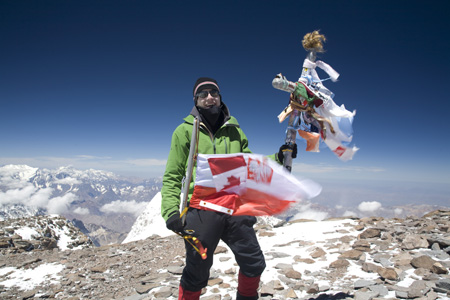
I had brought with me a flag of Canada and Poland, and flew them both together at the summit. The cross I am holding in my other hand is at the summit all the time, it is the sign of Aconcagua’s summit. A picture with it means you made it to the top.
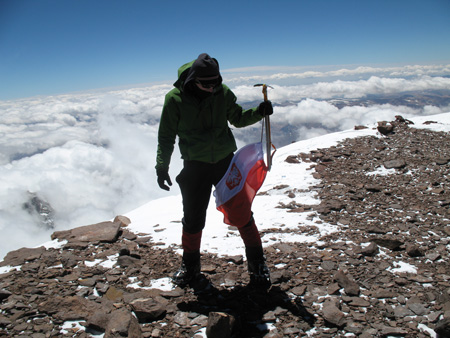
Looking the other way, the clouds and the mountains surrounding us are so low, it really feels like the top of the world. We didn’t have that clear a view of the mountains below, but it was still magnificent, more than we could ask for!
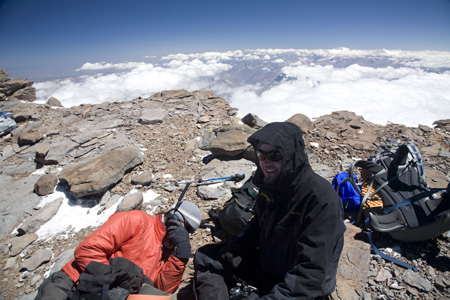
Trying to stay low to stay out of the wind, we see Ryan calling in the news that we had made the summit! Emil is also taking a break and sitting down. I think I spent the entire time on the summit walking around, taking pictures, trying to get it all in. I am not sure if I even sat down at all, that’s how exciting it was! It also got cold when sitting so that may have had something to do with it!
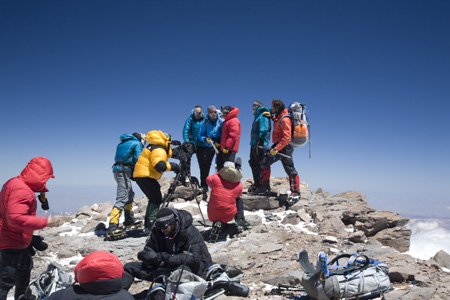
Above what you see is a group of mountain guides and some clients making a bit of a promotional video on the summit of Aconcagua. It was a group of American mountain guides promoting Eddie Bauer’s latest line of mountaineering gear called First Ascent. The guides are quite famous in mountaineering circles (in the US anyways); one of them was Ed Viesturs, the only American to have summited all fourteen 8000+ meter peaks without oxygen. He was also in the IMAX movie about Everest that was filmed in 1996. Dave Hahn was another, he went on later that year to summit Everest for the eleventh time, more than any non-sherpa in history. I have been trying to find some video footage from that group (since I could maybe find myself in some of the shots ;-)) but all I have seen from it is their web page here.
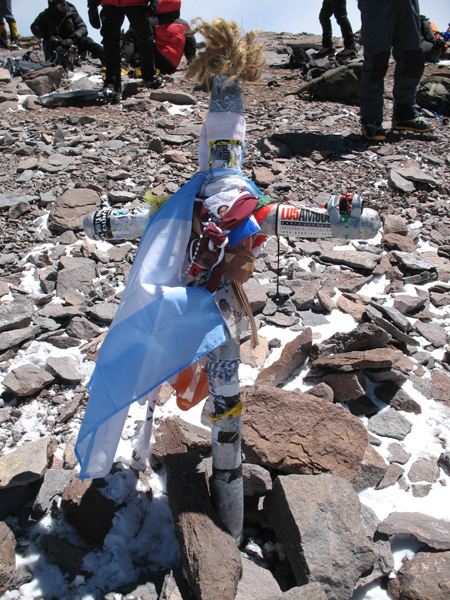
One of the last pictures from the summit is the one of the cross I spoke of above, the sign of Aconcagua’s summit. What I want to point out here is that I left a picture of Iván Berdeja tucked into the cross, after having written a little note about him on the back. He is a mountain guide who helped me set up my climb in Bolivia, and he later died while guiding for another group. I mentioned it here in a previous post, and it was an absolute honor to make it to the top and be able to do what I was asked.
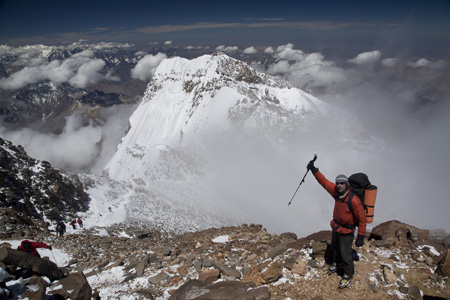
That was about all the time we had on the summit. We spent just under half an hour on the top, and it flew by like no time at all. The one thing that reminded us how long we had been on the summit was how cold we were getting. The last picture you see here is Ryan leading the way down, and you can see that we are headed directly into the clouds that are coming in. It made me realize the age-old saying, that when you reach the summit you are only half way there, you still have to get off the mountain.
So stay tuned for the next installment where we head into the clouds and try to make our way all the way back down.

